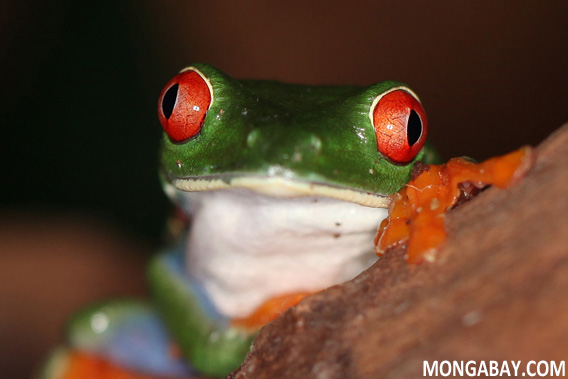
Red-eyed tree frog. Photo by Rhett A. Butler.
The number of amphibians described by scientists now exceeds 7,000, or roughly 3,000 more than were known just 25 years ago, report researchers in Berkeley.
David Wake, an emeritus biology professor at the University of California, this week announced the 7,000th amphibian cataloged on AmphibiaWeb, a project which since 2000 has sought to document every one of Earth’s living frogs, salamanders, newts, and caecilians. The 3,000 ‘new’ species means that scientists have described a previously unknown amphibian every two-and-a-half days since 1987. And the rate of new species descriptions may be accelerating: 100 species have been described so far in 2012.
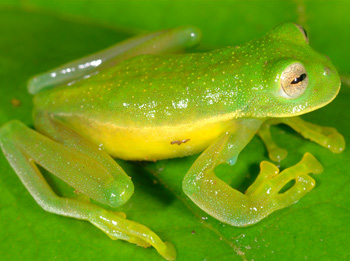 The 7000th amphibian added to AmphibiaWeb was Centrolene sabini, a glass frog from Manu National Park in the Peruvian Amazon. Photo by Alessandro Catenazzi, the researcher who was the lead author of the paper that described the species. |
But the discoveries mask bad news: global amphibian populations are in sharp decline due to the effects of climate change, habitat destruction, pollution, invasive species, overharvesting as food and for the pet trade, and the spread of chytridiomycosis, a deadly fungal disease. The IUCN Red List estimates that more than 40 percent of amphibians are at risk, while more than 150 species are known to have gone extinct since the early 1980s.
AmphibiaWeb documents the known status of each and every species. Beyond photos, maps, and information, the site also collects audio clips of frog calls. Wake said AmphibiaWeb had become the global authority for amphibian information.
“We are the place for accurate, vetted information on amphibians,” he said in a statement, noting the site is queried 15,000 and 20,000 times per day.
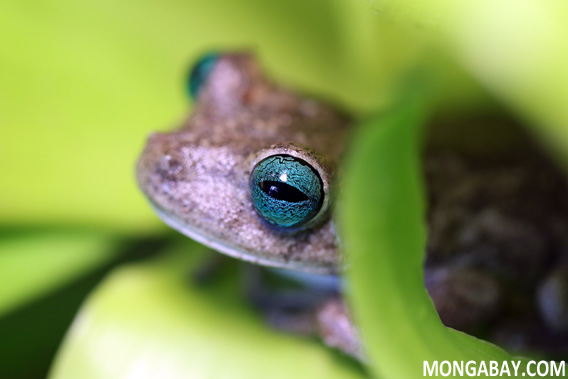
Hypsiboas crepitans tree frog. Photo by Rhett A. Butler.
More amphibian pictures
CITATION: Catenazzi, A., Von May, R., Lehr, E., Gagliardi-Urrutia, G., Guayasamin, J.M. (2012). ”A new, high-elevation glassfrog (Anura: Centrolenidae) from Manu National Park, southern Peru.” Zootaxa, 3388, 56-68.
Related articles
EPA considers ban on herbicide that triggers sex reversal in frogs
(06/08/2012) The Environmental Protection Agency (EPA) will weigh a ban on Atrazine, a widely used herbicide linked to sex reversal and other reproductive problems in amphibians and fish. The chemical, which is manufactured by Syngenta, has been banned in the European Union since 2004 but some 80 million pounds Atrazine are applied to corn, sugarcane, sorghum and rice in the United States each year.
Frog photos for Save the Frogs Day
(04/28/2012) Today is Save the Frogs Day, a global event that aims to raise awareness on the plight of amphibians, which are increasingly endangered by climate change, habitat loss and degradation, pollution, invasive species, overexploitation, and the outbreak of a deadly fungal disease. In recognition of Save the Frogs Day, there are dozens of activities occurring around the world.
Mad frog bonanza: up to 36 new frogs discovered in tiny Madagascar forest
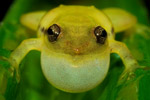
(04/19/2012) A forest less than half the size of Manhattan sports an astounding number of frogs, according to a new paper in Biodiversity Conservation. Two surveys of Madagascar’s Betampona Nature Reserve, which covers 2,228 hectares, has uncovered 76 unique frogs, 36 of which may be new to science. To put this in perspective: the U.S. and Canada combined contain just 88 frog species, but cover an area nearly a million times larger than Betampona.
Vampire and bird frogs: discovering new amphibians in Southeast Asia’s threatened forests
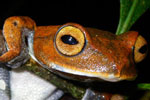
(02/06/2012) In 2009 researchers discovered 19,232 species new to science, most of these were plants and insects, but 148 were amphibians. Even as amphibians face unprecedented challenges—habitat loss, pollution, overharvesting, climate change, and a lethal disease called chytridiomycosis that has pushed a number of species to extinction—new amphibians are still being uncovered at surprising rates. One of the major hotspots for finding new amphibians is the dwindling tropical forests of Southeast Asia.
The dark side of new species discovery
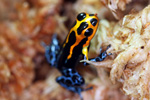
(12/21/2011) Scientists and the public usually rejoice when a new species is discovered. But biologist Bryan Stuart has learned the hard way that the discovery of new species, especially when that species is commercially valuable, has a dark side-one that could potentially wipe out the new species before protections can be put in place. Stuart has discovered 27 species unknown previously to scientists – so far. That includes 22 species of frogs, three types of snakes, and two salamanders. His experience with one of these, a warty salamander from Laos with striking markings (Laotriton laoensis), opened his eyes to a dark side of scientific discovery: commercial overexploitation before protections are in place. Shortly after Stuart described the previously unknown species Paramesotriton laoensis in a scientific paper published in 2002, commercial dealers began collecting this Lao newt for sale into the pet trade. In essence, the dealers used Stuart’s geographic description in the paper as a “roadmap” to find the rare newt.
Herpetology curator: behind-the-scenes of ‘new species’ discoveries
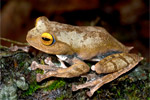
(12/18/2011) Bryan Stuart’s mission as a curator of amphibians and reptiles at the North Carolina Museum of Natural Sciences is to understand the diversity of life on earth. For that, he documents what species occur where and why. He’s particularly attracted to areas where there’s a dearth of knowledge, like Laos, Cambodia, Vietnam and Gabon, and so far has discovered 27 species unknown previously to scientists: three species of snakes, two types of salamanders, and 22 kinds of frogs.